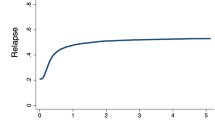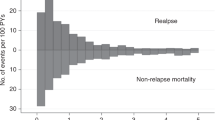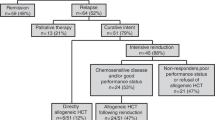Abstract
Relapse after allogeneic hematopoietic SCT (HSCT) carries a poor prognosis and is a common cause of death. Outcomes of children who relapse post HSCT are not well known. In this retrospective multicenter study we included 532 patients who underwent allogeneic HSCT and examined the outcomes of 160 patients (30%) who relapsed. Treatment options after relapse included (i) palliative therapy with non-curative intent (n=43), (ii) salvage chemotherapy (without a second HSCT, n=55) or (iii) salvage chemotherapy followed by a second HSCT (n=62). Sixty two patients underwent a second HSCT. The 1-year disease-free survival (DFS) for those given palliative therapy, chemotherapy alone and who underwent a second transplant was <1%, 9% and 50% (P=<0.0001), respectively. The DFS at 1 and 2 year was 50% and 35%, respectively, among the patients who received a second transplant versus 9% and 2% in those who did not (P=<0.0001). In multivariable analysis longer time to relapse (P=0.04) and undergoing a second HSCT (P<0.001) were associated with improved outcome. Withdrawal of immunosuppressive therapy, followed by curative intent chemotherapy should be offered to all patients who relapse after an allogeneic HSCT. A second HSCT should be considered, especially in patients who respond to salvage chemotherapy.
This is a preview of subscription content, access via your institution
Access options
Subscribe to this journal
Receive 12 print issues and online access
$259.00 per year
only $21.58 per issue
Buy this article
- Purchase on Springer Link
- Instant access to full article PDF
Prices may be subject to local taxes which are calculated during checkout


Similar content being viewed by others
References
Van den Brink MR, Porter DL, Giralt S, Lu SX, Jenq RR, Hanash A et al. Relapse after allogeneic hematopoietic cell therapy. Biol Blood Marrow Transplant 2010; 16 (1 Suppl): S138–S145.
Spyridonidis A, Labopin M, Schmid C, Volin L, Yakoub-Agha I, Stadler M et al. Outcomes and prognostic factors of adults with acute lymphoblastic leukemia who relapse after allogeneic hematopoietic cell transplantation. An analysis on behalf of the acute leukemia working party of EBMT. Leukemia 2012; 26: 1211–1217.
Kobayashi K, Kami M, Murashige N, Kusumi E, Kishi Y, Hamaki T et al. Outcomes of patients with acute leukaemia who relapsed after reduced-intensity stem cell transplantation from HLA-identical or one antigen-mismatched related donors. Br J Haematol 2005; 129: 795–802.
Michallet M, Tanguy ML, Socie G, Thiebaut A, Belhabri A, Milpied N et al. Second allogeneic haematopoietic stem cell transplantation in relapsed acute and chronic leukaemias for patients who underwent a first allogeneic bone marrow transplantation: a survey of the Societe Francaise de Greffe de moelle (SFGM). Br J Haematol 2000; 108: 400–407.
Kurosawa S, Fukuda T, Tajima K, Saito B, Fuji S, Yokoyama H et al. Outcome of 93 patients with relapse or progression following allogeneic hematopoietic cell transplantation. Am J Hematol 2009; 84: 815–820.
Bethge WA, Storer BE, Maris MB, Flowers ME, Maloney DG, Chauncey TR et al. Relapse or progression after hematopoietic cell transplantation using nonmyeloablative conditioning: effect of interventions on outcome. Exp Hematol 2003; 31: 974–980.
Porter DL, Alyea EP, Antin JH, DeLima M, Estey E, Falkenburg JH et al. NCI first international workshop on the biology, prevention, and treatment of relapse after allogeneic hematopoietic stem cell transplantation: report from the committee on treatment of relapse after allogeneic hematopoietic stem cell transplantation. Biol Blood Marrow Transplant 2010; 16: 1467–1503.
Mielcarek M, Storer BE, Flowers ME, Storb R, Sandmaier BM, Martin PJ . Outcomes among patients with recurrent high-risk hematologic malignancies after allogeneic hematopoietic cell transplantation. Biol Blood Marrow Transplant 2007; 13: 1160–1168.
Eapen M, Giralt SA, Horowitz MM, Klein JP, Wagner JE, Zhang MJ et al. Second transplant for acute and chronic leukemia relapsing after first HLA-identical sibling transplant. Bone Marrow Transplant 2004; 34: 721–727.
Bosi A, Laszlo D, Labopin M, Reffeirs J, Michallet M, Gluckman E et al. Second allogeneic bone marrow transplantation in acute leukemia: results of a survey by the European Cooperative Group for Blood and Marrow Transplantation. J Clin Oncol 2001; 19: 3675–3684.
Acknowledgements
Author Contributions: RB and HF contributed to the research design. RB, TS, AG, JD, IS, KG, DT, SR, JD and HF were involved in the acquisition of data. Analysis or interpretation of data was done by RB, HF, YM, SS, TS, DT, JD, IS, KG, SR and JD. Drafting, critical revision of the paper, as well as approval of the submitted and final version of the paper was done by RB, HF, YM, SS, TS, AG, JD, IS, KG, DT, SR and JD.
Author information
Authors and Affiliations
Corresponding author
Ethics declarations
Competing interests
The authors declare no conflict of interest.
Rights and permissions
About this article
Cite this article
Bajwa, R., Schechter, T., Soni, S. et al. Outcome of children who experience disease relapse following allogeneic hematopoietic SCT for hematologic malignancies. Bone Marrow Transplant 48, 661–665 (2013). https://doi.org/10.1038/bmt.2012.209
Received:
Revised:
Accepted:
Published:
Issue Date:
DOI: https://doi.org/10.1038/bmt.2012.209
Keywords
This article is cited by
-
Effects of second transplantation with T-cell-replete haploidentical graft using low-dose anti-thymocyte globulin on long-term overall survival in pediatric patients with relapse of leukemia after first allogeneic transplantation
International Journal of Hematology (2022)
-
Outcomes of pediatric patients who relapse after first HCT for acute leukemia or MDS
Bone Marrow Transplantation (2021)
-
Prognosis of relapse after hematopoietic cell transplant (HCT) for treatment of leukemia or myelodysplastic syndrome (MDS) in children
Bone Marrow Transplantation (2019)
-
Treatment of relapse after allogeneic stem cell transplantation in children and adolescents with ALL: the Frankfurt experience
Bone Marrow Transplantation (2017)
-
Factors associated with improved outcomes after second allogeneic hematopoietic cell transplantation for relapsed pediatric leukemia
Annals of Hematology (2016)



